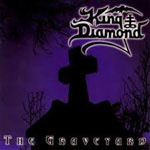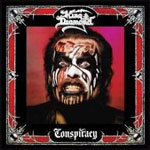Features
Invisible Guests
King Diamond Albums Ranked Worst To Best
by Christopher Thelen
After plowing through eleven Mercyful Fate albums in the course of four days, you might think that your faithful scribe would have had enough of material featuring King Diamond.
But with the reissues of Diamond’s first albums recorded for Roadrunner being released, as well as the earliest Mercyful Fate albums, as well as the promise of a new album (The Institute), it seemed like the right time to tackle Diamond’s vast discography and attempt to rank them, worst to best. Please note: I started writing this prior to the reissues coming out, so the opinions are based on the releases available at the time.
With such a vast discography, one needs to make some cuts. Naturally, any best-of will not be included in this list. I’m also choosing to solely focus on the studio releases, meaning live albums like In Concert 1987: Abigail and most recent release Songs For The Dead are not being considered.
I am likewise opting not to include two EPs that Diamond released – No Presents For Christmas and The Dark Sides – simply because the songs on these that weren’t culled from a then-current studio release have all found their way onto re-releases of albums as bonus tracks. (It should be noted that the 2020 re-releases on Metal Blade feature only the original albums, with none of the bonus material.)
Finally… I’m making the difficult decision not to include King Diamond & Black Rose’s 20 Years Ago: A Night Of Rehearsal, simply because this is more of a historical piece of Diamond’s career pre-Mercyful Fate. Its exclusion is by no means an indictment of the album, but by the strictest definition, it’s not really part of Diamond’s solo studio discography. (Even Diamond’s official website lists the disc as a “compilation,” so I feel a little justified.)
Keep your hands in the carriage, and watch out for anything moving in the graveyards we pass, ’cause it’s time to dive into the discography. Don’t say you weren’t warned…
 12. The Spider’s Lullabye (1995)
12. The Spider’s Lullabye (1995)
The first release for Diamond as a solo artist in five years (partially due to the reformation of Mercyful Fate), this was also the first disc to not be a complete concept album in nine years. The four songs that do make up the tale of the album’s title are the makings of a horror movie, to be certain… except there is no real terror in the background story. Quite possibly, this was a case of Diamond spreading himself too thin (though he would continue to alternate between Mercyful Fate and solo releases for a few years); perhaps, had he put all his focus on the storyline, this could have been a better album. The remaining six songs occasionally tease previous albums, as if these were leftovers from those eras, but overall the album is a disappointment. Worth Checking Out: “Killer,” “Six Feet Under,” “Room 17”
11. Give Me Your Soul… Please (2007)
As of this writing, the last solo studio effort from Diamond, it was recorded at a time when Diamond was experiencing serious health problems, which do affect his vocal power negatively (including a significant scaling back of his falsetto, which some listeners surprisingly approved of). Similarly, it’s hard to say that this album is particularly scary; while it does have a dark back story, it doesn’t evoke the sense of fear and dread that other albums just oozed. What saves this album is the musical performances, which could rank as some of the most powerful in many years. A pity that the overall disc doesn’t match up to that high level of creativity…and while one can understand why the disc is weaker due to Diamond’s health (or admire the fact he wanted to get this out to his fans), it still is a letdown. Worth Checking Out: “Mirror Mirror,” “The Cellar”
 10. The Eye (1990)
10. The Eye (1990)
One has to hand it to Diamond: he didn’t play it safe after three very successful concept albums and dared to create an album with its roots in actual individuals and their stories. But there was something definitely missing from this disc…perhaps it was the music had less of a progressive bent to the metal? Perhaps it was lacking the power drumming of Mikkey Dee (replaced on this disc by Snowy Shaw). Perhaps it was trying to work too many different story lines into 44 minutes? Or, perhaps a combination of all these factors? Whatever the case, overall the album is a letdown and just not as captivating as Diamond’s earlier works. Worth Checking Out: “The Trial (Chambre Ardente),” “Burn”
9. Abigail II: The Revenge (2002)
Let’s get one thing clear at the beginning: Abigail did not need a sequel, as there were no loose ends in the story that Diamond told all those years ago. Yet 15 years later, we’re given a second chapter of the tale, where the demon child supposedly taken at the end of the first story to be killed is spared, and she returns to the mansion that should have been her home to exact revenge. I’ll admit, my stance toward this album has softened over the years, and I fully expected this disc to be bringing up the rear of this list. But, surprisingly, it holds its own, even if it tries to build on a near-perfect original story. Is it great? No. Is it a disc you must own? No. Is it listenable? Yes…and at least worth one listen. Worth Checking Out: “Little One,” “The Crypt,” “Mommy”
 8. Voodoo (1998)
8. Voodoo (1998)
On this release, Diamond again proves he’s not afraid to work different musical styles or themes into his tales. With definite voodoo beats in some of the songs on this disc, he creates challenging music for both his band and the listener, and in the end, it is well worth the effort. (If anything, the disc might have benefitted by having more of those influences in the music.) However, story-wise, it’s not as strong as its predecessor, though it’s by no means a bad disc. I’m guessing that, after the sheer terror of The Graveyard, Diamond took his foot off the gas a little bit. Worth Checking Out: “‘LOA’ House,” “Salem,” “Cross Of Baron Samedi”
7. House Of God (2000)
By all rights, the storyline of this album should have been the scariest thing Diamond had created to this point in his career, challenging the listener’s view of religion. But something just keeps this disc from reaching that creative apex it should have…possibly production that lacks a true low-end? Or is it a little too much reliance on the cursed love story in the first half of the album, and not enough about the torture and discoveries in the second half? In the end, this is a good Diamond solo effort, but compared to others in his catalog, not a great one. Worth Checking Out: “House Of God,” “Catacomb,” “This Place Is Terrible”
 6. The Puppet Master (2003)
6. The Puppet Master (2003)
In one of his stronger latter-career efforts, Diamond again is able to paint an extremely macabre picture lyrically, with a strong musical background. It’s not quite as strong as The Graveyard, but it’s a very close second in terms of being Diamond’s darkest subject matter. Diamond’s wife Livia Zita adds necessary color as the voice of Victoria, and proves she’s a very capable vocalist in her own right. The companion DVD, featuring Diamond telling the story song-by-song, sometimes explains some of the action in the story, but actually does the album itself a disservice by stealing some of the story’s thunder (even though it is fun to see Diamond tell the tale in person). Worth Checking Out: “Blue Eyes,” “No More Me,” “Living Dead”
5. The Graveyard (1996)
After two mediocre efforts, Diamond returns to the concept album theme with a story which could be his downright scariest. Telling the story of an individual who escapes a mental institution (after being placed there by the mayor of the town under false circumstances), he kidnaps the mayor’s daughter and threatens to kill her unless he takes part in a cruel game. The music is good, though it’s less of a metal album per se than a musical tale of the macabre, which does fit Diamond well. But the theme is so dark that it is not always the most comfortable listen – and this is coming from an artist whose career has not exactly been sunshine and roses. A powerful, if not unnerving, return to form for Diamond. Worth Checking Out: “Waiting,” “Sleep Tight, Little Baby”
 4. Fatal Portrait (1986)
4. Fatal Portrait (1986)
Diamond’s first solo effort is one of the few albums he’s recorded that does not maintain a storyline throughout all of the songs. While this disc contains some very strong material, that lack of complete continuity does undercut the album’s power. Anyone picking this disc up expecting the Satanic overtones that made up the two early Mercyful Fate albums will be disappointed, but the story of a little girl’s soul trapped in a book (and subsequently released to haunt her mother) should, in the end, be fairly pleasing to all. Worth noting: re-releases of this disc include the title track from Diamond’s first solo EP No Presents For Christmas and “The Lake” from The Dark Sides (as well as being the B-side to the “Halloween” single). Worth Checking Out: “Dressed In White,” “Halloween”
3. Conspiracy (1989)
The second half of the tale started on the previous year’s “Them,” this disc has the crispest sound of all of Diamond’s albums to this point, and musically it’s possibly the strongest. But the overall story seems to just be an unnecessary add-on to the tale of King, “Them” and the house of Amon, and is neither as sinister nor scary as its predecessor. Still a strong album that holds its own quite well. Worth Checking Out: “Sleepless Nights,” “A Visit From The Dead,” “Victimized”
 2. Abigail (1987)
2. Abigail (1987)
The first complete concept album from Diamond is, quite possibly, his creative peak. With a story that is fairly easy to understand (so long as one has the lyrics in front of them), Abigail is a musical and lyrical masterpiece that makes the listener’s mind create a movie from both sources. Re-releases of this album include three rough mixes as bonus tracks, as well as the B-side from “The Family Ghost” single “Shrine.” Worth Checking Out: “The Family Ghost,” “Abigail,” “Black Horsemen”
1. “Them” (1988)
While the overall story is not as user-friendly as Abigail (if such a phrase can be used for any of his albums), it is a far more powerful story, backed up with progressive-influenced chops that simply capture the listener and refuse to let go until the final note has faded out. With Diamond himself becoming a character in this story, he becomes enamored with the voices in the house of Amon, until the intervention of his sister in the nightly other-worldly activities. There’s a reason this disc is considered Diamond’s masterpiece – and, honestly, while it took me over 30 years to appreciate it, I understand why now. Re-releases of this album include two rehearsal takes on songs, as well as “Phone Call” originally released on The Dark Sides EP (although one could argue it doesn’t really follow the storyline on the original album). Worth Checking Out: “The Invisible Guests,” “Tea”